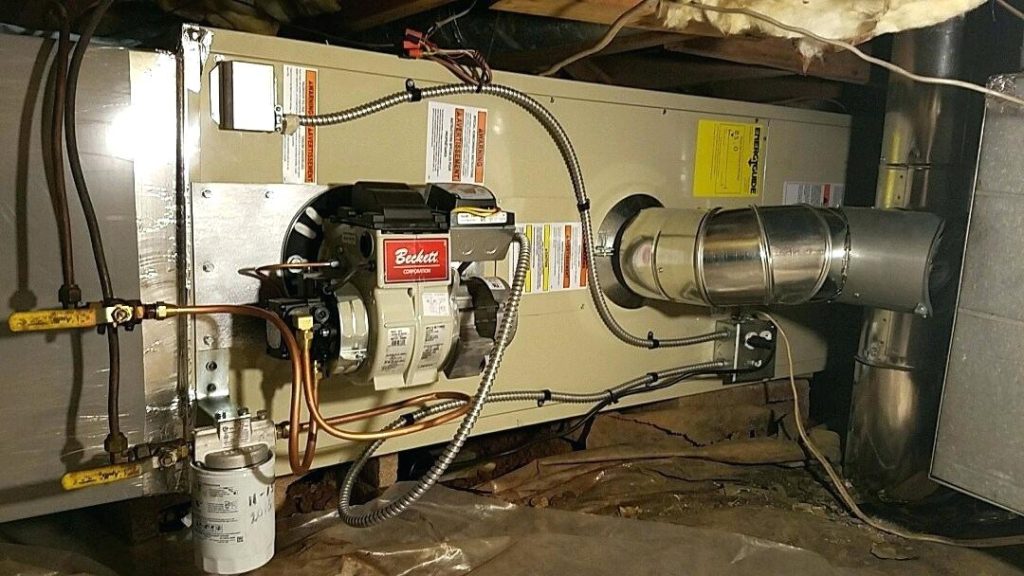If you’re in the market for a home heating solution, the prospect of choosing an oil furnace might have crossed your mind. The reliability and efficiency of these systems make them a popular choice, but understanding the intricate details of how they function is crucial. In this comprehensive guide, we will delve into the working mechanisms of oil furnaces, explore the temperatures they can reach, examine potential hazards, and highlight essential maintenance considerations.
Unraveling The Inner Workings

Oil furnaces are sophisticated heating systems designed to maintain optimal room temperatures. The process begins with the thermostat detecting temperature fluctuations. Once the room temperature falls below the preset level, the thermostat signals the oil furnace into action.
Activated by this signal, the furnace draws oil from a reserve tank, passing it through a filter before entering the burning chamber. In this chamber, the oil transforms into a mist, a crucial step in the combustion process. The mist combines with air and ignites, creating a substantial amount of heat.
As the combustion chamber becomes intensely hot, the generated heat is absorbed by the surrounding air through a heat exchanger. The heated air is then propelled into the ducts by a blower, facilitating its distribution throughout the house. However, as this heated air travels through the ductworks, it gradually loses some of its intensity.
Temperature Dynamics In Action
When your oil furnace is in operation, it can produce air with temperatures ranging between 140-170 degrees Fahrenheit. This heated air is the key to keeping your home comfortably warm during colder months. However, as it navigates through the ductworks, it undergoes a noticeable loss of energy.
On the other hand, the flue pipe, a critical component responsible for expelling by-products, can reach considerably higher temperatures, ranging from 350-700 degrees Fahrenheit. Monitoring these temperatures is crucial not only for understanding the efficiency of your oil furnace but also for identifying potential issues that may arise.
Unveiling Potential Dangers
While oil furnaces excel at providing efficient heating, they are not without their potential dangers. The combustion process results in the production of by-products, including nitrogen, carbon dioxide, water vapor, and the particularly hazardous carbon monoxide. Although instances of carbon monoxide poisoning are rare, they emphasize the importance of regular maintenance.

To safeguard against potential dangers, homeowners are advised to install carbon monoxide detectors and ensure that the flue pipe is in optimal condition. A malfunctioning flue pipe can lead to the buildup of dangerous gases within the home, posing significant health risks.
Crucial Role Of Flue Pipe Maintenance
The flue pipe serves as the essential conduit for removing harmful by-products from your home. Regular inspections by a qualified service technician are paramount to ensure that the flue pipe is clear and functioning correctly. Any abnormalities or blockages in the flue pipe should be promptly addressed to prevent potential hazards.
Fire Hazards And Furnace Temperatures
One of the questions that often arise is whether an oil furnace can catch fire. The answer is affirmative, and there are specific factors that can contribute to this risk. A dirty or blocked filter, a cracked heat exchanger, or inadequate clearance around the furnace are potential fire hazards.
Regular servicing, including filter replacement and ensuring proper clearance, is essential to mitigate the risk of fires. Additionally, homeowners should be cautious about placing flammable objects, such as cleaning solvents, gas cans, cloth, shelving, or wood, in close proximity to the oil furnace.
Flame Characteristics: A Window Into Furnace Health
The flame produced by an oil furnace can vary in temperature, with different sources providing varying optimal combustion temperatures. The color of the flame serves as a visual indicator of the furnace’s airflow. A mixture of white, chrome, and blue flames generally suggests that the furnace is receiving the correct mixture of air for combustion.
However, it’s important to note that the flame’s color can also be influenced by the furnace’s manufacturer. Some may exhibit a light yellow flame, which, depending on its darkness, can indicate either a lack or an abundance of air. Consulting the user’s manual for specific information regarding flame color is recommended.
Impact On Air Humidity
Contrary to some claims, oil furnaces may not necessarily contribute to dry air. While hot air has the capacity to hold more water vapor, the absolute humidity remains unchanged. To address the perception of dryness, homeowners can place a container of water in the room to facilitate evaporation and add humidity to the air.
Furnace Cycling And Overheating: Know The Signs
Oil furnaces undergo cycles of turning on and off based on temperature fluctuations. Factors such as furnace size, insulation, and outdoor temperature influence the frequency of these cycles. However, excessive cycling may indicate underlying issues, including an oversized furnace, insufficient insulation, or problems with the thermostat.
Overheating is another concern that homeowners should be aware of. A safety switch is designed to activate in the event of overheating, shutting down the system temporarily. In extreme cases, overheating can lead to fires. Common causes of overheating include blocked vents, a dirty air filter, a malfunctioning blower fan, cracks in the heat exchanger, or damaged evaporator coils.
Remedies For Overheating Issues

To address overheating problems, homeowners may need to implement various solutions based on the specific part causing the issue. If the heat exchanger is cracked, replacement may be necessary. Regular maintenance, including filter replacement and cleaning of components like blower fans and evaporator coils, is essential to prevent overheating.
Conclusion
In conclusion, oil furnaces are intricate systems that demand a nuanced understanding for efficient and safe operation. Regular inspections, proper maintenance, and adherence to safety guidelines are paramount to ensuring the longevity of the system and the well-being of your home. By staying informed and proactive, homeowners can navigate the complexities of oil furnaces and enjoy reliable heating throughout the colder seasons.






GIPHY App Key not set. Please check settings